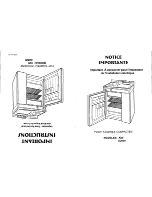
4.The need to not exceed the storage time(s) recommended by the food manufacturers for any kind of food
5. The fact that a rise in temperature of the frozen food during manual defrosting, maintenance or cleaning could
shorten the storage life
6. It is better wrapping the frozen food in several layers of the glass shelves.
7. the care required with regard to frozen food in storage in the event of an extended non-running of the refrigerating
appliance (interruption of power supply or failure of the refrigerating system)
Tips for keeping food perfect in the Fridge
Take extra care with meat and fish
Cooked meats should always be stored on a shelf above raw meats to avoid bacterial transfer. Keep raw meats on a plate
which is large enough to collect juices and cover it with cling film or foil.
Leave space around food
This allows cold air to circulate around the Fridge, ensuring all parts of the Fridge are kept cool.
Wrap up food!
To prevent transfer of flavors and drying out, food should be separately packed or covered. Fruit and vegetables need not
be wrapped.
Pre-cooked food should be cooled properly
Allow pre-cooked food to cool down before placing in the Fridge. This will help to stop the internal temperature of the
Fridge from rising.
Shut the door!
To prevent cold air escaping, try to limit the number of times you open the door. When retuning from shopping, sort foods
to be kept in your Fridge before opening the door. Only open the door to put food in or take it out.
Where to store your foods in the fridge
Cool area
This is where to store foods which will keep longer if they are kept cool. Milk, eggs, yogurt, fruit juices, hard cheeses eg.
Cheddar. Opened jars and bottles of salad dressings, sauces and jams. Fats, eg. Butter, margarine, low-fat speads,
cooking fats and lard.
Coldest area
This is where foods which must be cold to keep them safe should be kept:
·
Raw and uncooked foods should always be wrapped.
·
Pre-cooked chilled foods, eg. Ready meals, meat pies, soft cheeses.
·
Pre-cooked meats eg. Ham,
·
Prepared salads(including pre-packed mixed green salads, rice, potato salad etc).
·
Desserts, eg. Fromage frais, home-prepared food and leftovers or cream cakes.
NOTE
:
Always wrap and store raw meat, poultry and fish on the lowest shelf at the bottom of
the fridge. This will stop them dripping onto, or touching other foods. Do not store inflammable gasses or liquids in the
fridge.
Tips for shopping for frozen foods
Your Freezer is 4 star
When you are buying frozen food, look at the Storage Guidelines on the packaging. You will be able to store each item of
frozen food for the period shown against the 4 star rating. This is usually the period stated as “Best, Before”, found on the
front of the packaging.
Check the Fridge/Freezer temperature
Check the temperature of the frozen food cabinet in the shop where you buy your frozen foods. It should show a
temperature lower than -18
℃
.
Choose packs carefully
Make sure the frozen food package is in perfect condition.
Purchase frozen food last
Always buy frozen products last on your shopping trip or visit to the supermarket.
Keep frozen foods together
Try to keep frozen food together whilst shopping, and on the journey home as this will help to keep the food cooler.
Store food straight away
Don’t buy frozen food unless you can freeze it straight away. Special insulated bags can be bought from most
supermarkets and hardware shops. These keep frozen food cold for longer.
Thawing frozen food
For some foods, thawing before cooking is unnecessary. Vegetables and pasta can be added directly to boiling water or
steam cooked. Frozen sauces and soups can be put into a saucepan and heated gently until thawed.
Freezing fresh foods, useful tips
Use quality food and handle it as little as possible. Freeze food in small quantities, it freezes faster, takes less time to thaw
and enables you to eat it in the quantity you need.
Freezing fresh foods
First, estimate the amount of food you will be freezing. If you are freezing large amounts of fresh food, remember to turn
the control dial to Max. This will lower the temperature in the Freezer (approx -30
℃
), freezing your food quicker and
helping to keep the goodness in. However you should do this sparingly to conserve energy.
Preparations for freezing
·
Leave cooked food to cool completely.
·
Chill food in a Fridge before freezing if possible.
·
Consider how you want to cook the food before freezing it.
·
Don’t freeze food in metal containers as you may want to microwave it straight from the Freezer.
















































